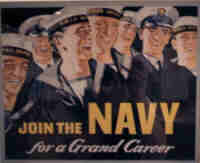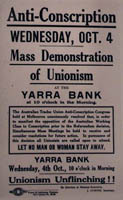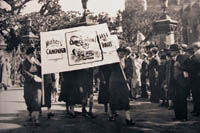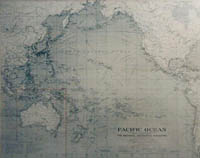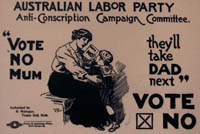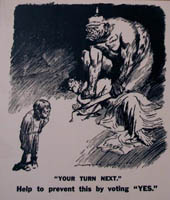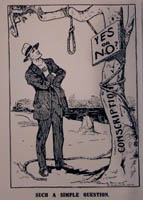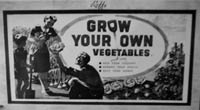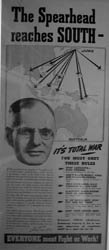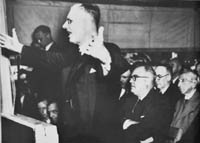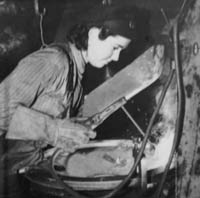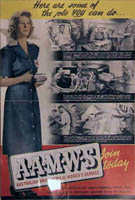
As wartime prime minister, Curtin struggled with some thorny personal dilemmas, but none caused him more soul searching than the issue of conscription. During World War I Curtin had argued passionately against compulsory enrolment for overseas military service. Yet in World War II he was responsible for its introduction, overturning one of the Labor Party's most sacred policies.
Military
recruitment poster for the
volunteer forces. National Archives of Australia C934/P1 Folder 6.
Publicity
authorised by Curtin for an anti-
conscription mass meeting during
World War I. State Library of Victoria Riley Collection.
AUSTRALIA'S TWO ARMIES - CONSCRIPTS AND VOLUNTEERS
When Curtin became Prime Minister in October 1941, just weeks before Japan was to enter the war, Australia effectively had two armies. The Australian Imperial Force (AIF) was made up of volunteers who could be called upon to fight anywhere in the world. The Commonwealth Military Force (CMF), also known as the Militia, consisted of conscripts who could only serve within Australia and its territories.
As the Pacific War intensified, Curtin faced mounting pressure to amalgamate the two armies, and to allow conscripts to fight overseas.
CURTIN'S DECISION
By the end of 1942 Curtin had reluctantly decided that the use of conscripts beyond Australia's territorial limits could no longer be avoided. Although the threat of outright invasion had largely subsided, Curtin argued publicly that conscripts were needed to defend Australia from Japanese attack.
In reality,
his decision was based on more complex political and strategic concerns.
Critics asked why US conscripts should be sent far from home to defend
Australia, while Australian conscripts could not fight beyond the territory
of Australian New Guinea. American General Douglas MacArthur argued privately
that until Australia devoted its all to the war effort, the US government
would provide no more resources to fight the Pacific War. Curtin also
saw that sending conscripts overseas would give Australia strength in
diplomatic dealings with Britain and the US after the war.
Map
of the SW Pacific region, showing
the extended boundary within which
Australian conscripts could serve following
the passing of the Militia Act in Feb 1943. National Archives of Australia A5954/1 1937/14.
THE HISTORIC SHIFT
After bitter debate within the party, Curtin convinced the ALP to accept a limited form of conscription for overseas service. In February 1943 the area in which CMF conscripts were permitted to serve was extended to cover Japanese-held islands south of the equator.
Some Labor die-hards damned Curtin as a traitor. Others saw him as a pragmatist, forced to adapt his firmly held beliefs in response to the crisis of World War II. After a lifetime's opposition to militarism, this was perhaps the toughest decision he ever had to make.
CONSCRIPTION
IN WORLD WAR I
Opposition to the conscription of men for overseas military service had long been a key policy of the ALP. During World War I, government attempts to introduce conscription divided the nation, and triggered a massive split in the party. Curtin himself fervently opposed conscription, and became secretary of the Trades Hall Council anti-conscription campaign.
'Such
a simple question'
World War I anti - conscription
cartoon, Australian Worker, 1917.
ALL
IN!
For most ordinary Australians, life on the home front during World War II was hard. Through rousing speeches and ceaseless campaigns, Curtin called on all Australians to support the war effort. Sacrifice and hard work became the order of the day.
Meat rationing in the butcher's shop. National Archives of Australia MP5/75.
EVERYTHING FOR THE WAR
In 1942 Curtin's government launched an 'austerity campaign' aimed at diverting as many of the nation's resources as possible to the war effort.
Rationing of clothing and food was introduced to ensure that everyone had fair access to scarce goods. Coupons had to be handed over along with money in order to buy any rationed goods.
Housewives were encouraged to recycle everything from food scraps to rags. Restrictions were placed on horse racing, alcohol sales and gambling.
Thousands of Australians invested their savings in government war loans which raised money for the war effort.
Ration
books containing coupons for food
and clothing were issued to all Australians. National Archives of Australia B4641/1, B1.
Wartime
government publicity
urging support for the war effort. National Archives of Australia C934/1, 10.
John
Curtin speaking in Sydney at the opening
of the First Liberty Loan, 1942. West Australian Newspapers Ltd.
HARD
WORK ON THE HOME FRONT
Under extraordinary wartime powers, the government conscripted both men and women to essential war work.
Men who worked in 'reserved occupations' were not allowed to enlist, and those employed in non-essential fields were directed to war-related industries.
Non-traditional
work such as arc-welding
was taken on by women in the war years. National Archives of Australia B5939/1 Box 4.
Although women did the same work as men, they were usually paid at only 60-75 per cent of the male rate.
Another 45,000
joined the three major women's forces established during World War II
- the Women's Auxiliary Australia Air Force (WAAAF), the Australian Women's
Army Service (AWAS) and the Women's Royal Australian Naval Service (WRANS).
Volunteer workers also pitched in, sending supplies to soldiers overseas and raising money for the war effort.
